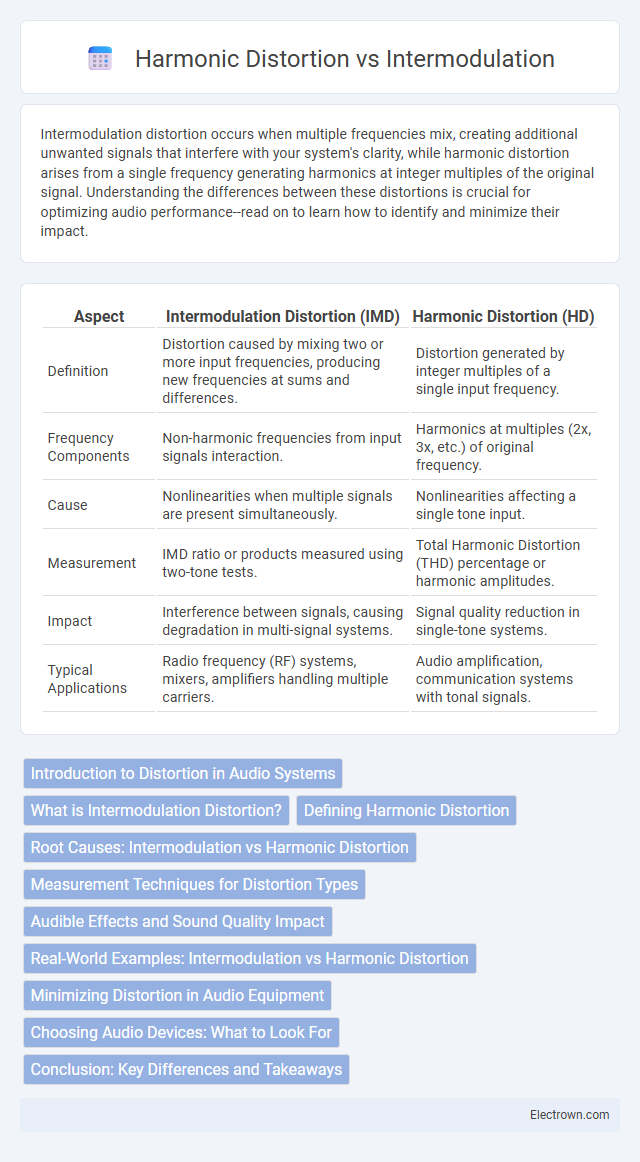Intermodulation distortion occurs when multiple frequencies mix, creating additional unwanted signals that interfere with your system's clarity, while harmonic distortion arises from a single frequency generating harmonics at integer multiples of the original signal. Understanding the differences between these distortions is crucial for optimizing audio performance--read on to learn how to identify and minimize their impact.
Table of Comparison
| Aspect | Intermodulation Distortion (IMD) | Harmonic Distortion (HD) |
|---|---|---|
| Definition | Distortion caused by mixing two or more input frequencies, producing new frequencies at sums and differences. | Distortion generated by integer multiples of a single input frequency. |
| Frequency Components | Non-harmonic frequencies from input signals interaction. | Harmonics at multiples (2x, 3x, etc.) of original frequency. |
| Cause | Nonlinearities when multiple signals are present simultaneously. | Nonlinearities affecting a single tone input. |
| Measurement | IMD ratio or products measured using two-tone tests. | Total Harmonic Distortion (THD) percentage or harmonic amplitudes. |
| Impact | Interference between signals, causing degradation in multi-signal systems. | Signal quality reduction in single-tone systems. |
| Typical Applications | Radio frequency (RF) systems, mixers, amplifiers handling multiple carriers. | Audio amplification, communication systems with tonal signals. |
Introduction to Distortion in Audio Systems
Distortion in audio systems occurs when the output signal deviates from the input, leading to altered sound quality. Intermodulation distortion arises from the interaction of multiple frequencies producing additional unwanted frequencies, while harmonic distortion results from the generation of harmonics at integer multiples of a single frequency. Understanding these distortions helps you maintain clarity and fidelity in audio reproduction.
What is Intermodulation Distortion?
Intermodulation distortion (IMD) occurs when multiple signals at different frequencies mix within a nonlinear system, producing new frequencies that are the sum and difference of the original signals. Unlike harmonic distortion, which generates integer multiples of a single frequency, IMD creates intermodulation products that result in complex spurious frequencies affecting signal clarity. IMD severely impacts audio systems, RF communication, and signal processing by introducing undesired interference and reducing overall performance quality.
Defining Harmonic Distortion
Harmonic distortion occurs when unwanted frequencies, which are integer multiples of a fundamental frequency, are introduced into an audio or signal output, altering the original waveform. Unlike intermodulation distortion, which creates new frequencies from the sum and difference of two or more signals, harmonic distortion primarily affects the signal by adding harmonics derived from the original tone. Understanding harmonic distortion helps you evaluate audio equipment's fidelity and ensures minimal alteration of the intended sound quality.
Root Causes: Intermodulation vs Harmonic Distortion
Intermodulation distortion arises from the nonlinear mixing of two or more different frequencies within a system, generating new frequencies at sums and differences of the original signals. Harmonic distortion is caused by the nonlinear response of a device creating integer multiples of a single input frequency, known as harmonics. Understanding the root causes of these distortion types helps you optimize audio or communication system performance by addressing specific nonlinearities.
Measurement Techniques for Distortion Types
Measurement techniques for intermodulation distortion (IMD) typically involve applying two or more test tones simultaneously and analyzing the resulting frequency spectrum for unwanted mixing products. Harmonic distortion measurement uses a single fundamental frequency input to detect harmonics generated at integer multiples of this frequency, quantifying the distortion levels. Accurate distortion characterization requires precise instrumentation and signal analysis methods tailored to distinguish between these unique nonlinear behaviors, helping you optimize audio and communication system performance.
Audible Effects and Sound Quality Impact
Intermodulation distortion creates complex, non-harmonic frequencies that can cause harsh, dissonant sounds, significantly degrading your audio clarity. Harmonic distortion generates integer multiples of the original signal frequencies, often perceived as a warmer or richer tone but can still reduce sound fidelity at high levels. Understanding these distinctions helps optimize your sound system for either clean accuracy or desired tonal coloration.
Real-World Examples: Intermodulation vs Harmonic Distortion
Intermodulation distortion occurs in audio systems when multiple signals mix, producing unwanted frequencies such as those found in distorted guitar amplifiers or multi-channel radio transmissions. Harmonic distortion arises when a single signal's harmonics are amplified, commonly heard in vintage tube amplifiers and electric piano effects. Understanding these distortions helps audio engineers optimize sound quality in devices like microphones, speakers, and broadcast equipment.
Minimizing Distortion in Audio Equipment
Minimizing distortion in audio equipment requires understanding the differences between intermodulation and harmonic distortion, as both affect sound quality differently. Intermodulation distortion occurs when multiple frequencies mix, creating additional unwanted frequencies, while harmonic distortion involves the generation of harmonics at multiples of the original frequency. You can reduce these distortions by using high-quality components, proper circuit design, and careful signal path optimization to ensure clearer and more accurate audio reproduction.
Choosing Audio Devices: What to Look For
When choosing audio devices, prioritize specifications that minimize both intermodulation distortion (IMD) and harmonic distortion (THD), as these affect sound clarity differently; IMD introduces unwanted frequencies from signal mixing, while THD adds harmonics at multiples of the original tone. Look for devices with low percentage values of IMD and THD, ensuring cleaner audio reproduction and more accurate sound. Your choice should balance both metrics to achieve the highest fidelity in audio performance.
Conclusion: Key Differences and Takeaways
Intermodulation distortion involves the mixing of multiple frequencies producing new unwanted frequencies, while harmonic distortion generates integer multiples of a single frequency. The key difference lies in intermodulation distortion's complex frequency interactions versus harmonic distortion's predictable harmonic series. Understanding these distinctions is crucial for diagnosing audio or RF system performance issues and optimizing signal clarity.
Intermodulation vs Harmonic Distortion Infographic

 electrown.com
electrown.com